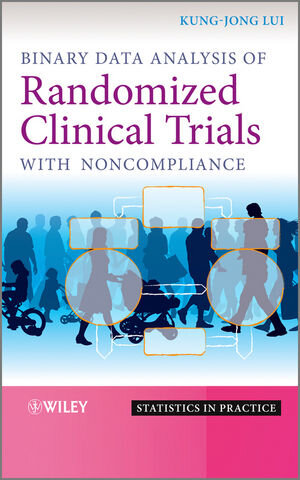
„The book would be well-suited as a reference for biostatisticians, clinicians, researchers, and data analysts - and it would be useful as supplemental reading for academic courses in a variety of related fields.“ (Book News, 1 August 2011)
Binary Data Analysis of Randomized Clinical Trials with Noncompliance
von Kung-Jong LuiIt is quite common in a randomized clinical trial (RCT) toencounter patients who do not comply with their assigned treatment. Since noncompliance often occurs non-randomly, the commonly-usedapproaches, including both the as-treated (AT) and as-protocol (AP)analysis, and the intent-to-treat (ITT) (or as-randomized)analysis, are all well known to possibly produce a biased inferenceof the treatment efficacy.
This book provides a systematic and organized approach toanalyzing data for RCTs with noncompliance under the mostfrequently-encountered situations. These include parallel sampling, stratified sampling, cluster sampling, parallel sampling withsubsequent missing outcomes, and a series of dependent Bernoullisampling for repeated measurements. The author provides acomprehensive approach by using contingency tables to illustratethe latent probability structure of observed data. Using real-lifeexamples, computer-simulated data and exercises in each chapter, the book illustrates the underlying theory in an accessible, andeasy to understand way.
Key features:
* Consort-flow diagrams and numerical examples are used toillustrate the bias of commonly used approaches, such as, ATanalysis, AP analysis and ITT analysis for a RCT withnoncompliance.
* Real-life examples are used throughout the book to explain thepractical usefulness of test procedures and estimators.
* Each chapter is self-contained, allowing the book to be used asa reference source.
* Includes SAS programs which can be easily modified incalculating the required sample size.
Biostatisticians, clinicians, researchers and data analystsworking in pharmaceutical industries will benefit from this book. This text can also be used as supplemental material for a coursefocusing on clinical statistics or experimental trials inepidemiology, psychology and sociology.
This book provides a systematic and organized approach toanalyzing data for RCTs with noncompliance under the mostfrequently-encountered situations. These include parallel sampling, stratified sampling, cluster sampling, parallel sampling withsubsequent missing outcomes, and a series of dependent Bernoullisampling for repeated measurements. The author provides acomprehensive approach by using contingency tables to illustratethe latent probability structure of observed data. Using real-lifeexamples, computer-simulated data and exercises in each chapter, the book illustrates the underlying theory in an accessible, andeasy to understand way.
Key features:
* Consort-flow diagrams and numerical examples are used toillustrate the bias of commonly used approaches, such as, ATanalysis, AP analysis and ITT analysis for a RCT withnoncompliance.
* Real-life examples are used throughout the book to explain thepractical usefulness of test procedures and estimators.
* Each chapter is self-contained, allowing the book to be used asa reference source.
* Includes SAS programs which can be easily modified incalculating the required sample size.
Biostatisticians, clinicians, researchers and data analystsworking in pharmaceutical industries will benefit from this book. This text can also be used as supplemental material for a coursefocusing on clinical statistics or experimental trials inepidemiology, psychology and sociology.






